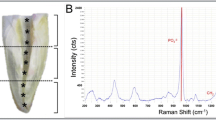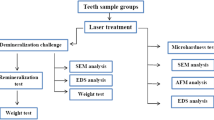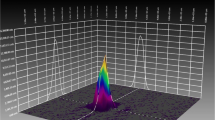Abstract
The root caries lesions still represent a health problem due to their rapid progression and, therefore, more efficient remineralization strategies are necessary. High-intensity lasers are useful because they modify the microstructure of the irradiated tissue due to heating; however, nothing is known about the effects of these lasers when associated with bioactive materials to remineralize caries lesions. This study evaluated the compositional changes that the Q-switched lasers emitted in the spectral region of infrared (IR, 1064 nm) and ultraviolet (UV, 355 nm) make in Biosilicate® on dentin with incipient caries lesion. Sixty blocks of demineralized root dentin were randomly divided into 6 experimental groups, to be treated with Biosilicate® alone (10% in fetal bovine serum), lasers alone (IR or UV, 5 ns, 10 Hz, 5 pulses/sample, 250 mJ/pulse or 100 mJ/pulse, respectively) or laser irradiations after 24 h of Biosilicate® application. After 24 h immersed in artificial saliva, samples were evaluated by Fourier transform infrared spectroscopy between 450 and 4000 cm−1. Laser irradiation alone reduced the organic, carbonate and water contents of the dentin, with greater effects promoted by the IR-laser as a result of heating. Biosilicate® alone elevated the content of phosphate and carbonate, which suggests formation of carbonated hydroxyapatite (HAC) on dentin. The irradiation with UV-laser after Biosilicate® also promoted an increase in the phosphate content, however there was less conversion of the biomaterial, evidenced by the rise in the intensity of the bands corresponding to the siloxane and amorphous phase of the apatite. Irradiation with IR-laser after Biosilicate®, on the other hand, promoted a significant increase in phosphate content when compared to the group treated with Biosilicate® alone, without the presence of siloxane bands. It was concluded that laser irradiation can augment the bioactivity of the Biosilicate®, evidenced by the greater formation of HAC and, for this, the wavelength of 1064 nm should be used.
Access this chapter
Tax calculation will be finalised at checkout
Purchases are for personal use only
Similar content being viewed by others
References
Pitts N, Zero D, Marsh P et al (2017) Dental caries. Nat Rev Dis Primers 3(17030):1–16
Nanci A (2007) Ten Cate’s oral histology: development, structure and function. Mosby, St. Louis Missouri
Tenuta LMA, Cerezetti RV, Del Bel Cury AA, Tabchoury CP, Cury JA (2008) Fluoride Release from CaF2 and Enamel Demineralization. J Dent Res 87:1032–1036
Featherstone JD (2000) Caries detection and prevention with laser energy. Dent Clin North Am 44:955–969
Antunes A, Vianna SS, Gomes ASL, de Rossi W, Zezell DM (2005) Surface morphology, elemental distribution, and spectroscopic changes subsequent the application of nanosecond pulsed Nd:YAG laser on dental enamel surface. Laser Phys Lett 2:141–147
Wheeler CR, Fried D, Featherstone JD, Watanabe LG, Le CQ (2003) Irradiation of dental enamel with Q-switched lambda = 355-nm laser pulses: surface morphology, fluoride adsorption, and adhesion to composite resin. Lasers Surg Med 32:310–317
Peitl O, Zanotto ED, Hench LL (2001) Highly bioactive P2O5-Na2O-CaO-SiO2 glass-ceramics. J Non-Cryst Solids 292:115–126
Queiroz CS (2004) Modelos de estudos in vitro para avaliar o efeito do fluoreto na desmineralização e remineralização do esmalte e dentina. Tese (Doutorado em Cariologia). Universidade Estadual de Campinas, Piracicaba
Hara AT, Queiroz CS, Giannini M, Cury JA, Serra MC (2004) Influence of the mineral content and morphological pattern of artificial root caries lesion on composite resin bond strength. Eur J Oral Sci 112:67–72
Tirapelli C, Panzeri H, Soares RG, Peitl O, Zanotto ED (2010) A novel bioactive glass-ceramic for treating dentin hypersensitivity. Braz Oral Res 24:381–387
Ana PA, Pereira DL, Ferreira ES, Figueredo DC, Daguano JKFB, Zezell DM (2019) Advances in the prevention and monitoring of root dentin demineralization using lasers. In: SBFoton proceedings of international optics and photonics conference (SBFoton IOPC). Sao Paulo, Brazil, pp 1–6. https://doi.org/10.1109/SBFoton-IOPC.2019.8910213
Baker MJ, Trevisan J, Bassan P et al (2014) Using fourier transform IR spectroscopy to analyze biological materials. Nat Protoc 9:1771–1791
Benetti C, Ana PA, Bachmann L, Zezell DM (2015) Mid-infrared spectroscopy analysis of the effects of erbium, chromium: yattrium-scandium-gallium-garnet (Er, Cr:YSGG) laser irradiation on bone mineral and organic components. Appl Spectrosc 69:1496–1504
Movasaghi Z, Rehman S, Rehman I (2008) Fourier transform infrared (FTIR) spectroscopy of biological tissues. Appl Spectrosc Rev 43:174–179
Pereira GS (2019) Caracterização e avaliação do Biosilicato® associado a laser de Nd:YAG para prevenção da cárie radicular. Dissertação (Mestrado em Biotecnociência). UFABC, Santo André
Acknowledgements
To FAPESP (2017-21887-4), PROCAD-CAPES (88881.068505/2014-01), National Institute of Photonics (CNPq/INCT 465763/2014-6), Multiuser Experimental Center of UFABC (CEM-UFABC) and Vitreous Materials Laboratory (LaMaV UFSCar). The authors are grateful to Prof. Oscar Peitl (UFSCar) for the methodological suggestions given in the course of the study.
Conflict of Interest
The authors declare that they have no conflict of interest.
Author information
Authors and Affiliations
Corresponding author
Editor information
Editors and Affiliations
Rights and permissions
Copyright information
© 2022 Springer Nature Switzerland AG
About this paper
Cite this paper
Rodrigues, M., Daguano, J.M.F.B., Ana, P.A. (2022). Chemical Effects of Nanosecond High-Intensity IR and UV Lasers on Biosilicate® When Used for Treating Dentin Incipient Caries Lesions. In: Bastos-Filho, T.F., de Oliveira Caldeira, E.M., Frizera-Neto, A. (eds) XXVII Brazilian Congress on Biomedical Engineering. CBEB 2020. IFMBE Proceedings, vol 83. Springer, Cham. https://doi.org/10.1007/978-3-030-70601-2_178
Download citation
DOI: https://doi.org/10.1007/978-3-030-70601-2_178
Published:
Publisher Name: Springer, Cham
Print ISBN: 978-3-030-70600-5
Online ISBN: 978-3-030-70601-2
eBook Packages: EngineeringEngineering (R0)




